Burrowing owl
| Burrowing owl | |
|---|---|
.jpg) | |
| Brazilian burrowing owl A. c. grallaria Pantanal, Brazil | |
| Scientific classification | |
| Kingdom: | Animalia |
| Phylum: | Chordata |
| Class: | Aves |
| Order: | Strigiformes |
| Family: | Strigidae |
| Genus: | Athene |
| Species: | A. cunicularia |
| Binomial name | |
| Athene cunicularia (Molina, 1782) | |
| Subspecies | |
|
About 20 living, see text | |
 | |
| Range of A. cunicularia Summer breeding range Winter non-breeding range Resident breeding range | |
| Synonyms | |
|
Strix cunicularia Molina, 1782 | |
The burrowing owl (Athene cunicularia) is a small, long-legged owl found throughout open landscapes of North and South America. Burrowing owls can be found in grasslands, rangelands, agricultural areas, deserts, or any other open dry area with low vegetation.[2] They nest and roost in burrows, such as those excavated by prairie dogs (Cynomys spp.). Unlike most owls, burrowing owls are often active during the day, although they tend to avoid the midday heat. Like many other kinds of owls, though, burrowing owls do most of their hunting from dusk until dawn, when they can use their night vision and hearing to their advantage. Living in open grasslands as opposed to forests, the burrowing owl has developed longer legs that enable it to sprint, as well as fly, when hunting.
Description
Burrowing owls have bright eyes; their beaks can be dark yellow or gray depending on the subspecies. They lack ear tufts and have a flattened facial disc. The owls have prominent white eyebrows and a white "chin" patch which they expand and display during certain behaviors, such as a bobbing of the head when agitated.
Adults have brown heads and wings with white spotting. The chest and abdomen are white with variable brown spotting or barring, also depending on the subspecies. Juvenile owls are similar in appearance, but they lack most of the white spotting above and brown barring below. The juveniles have a buff bar across the upper wing and their breast may be buff-colored rather than white. Burrowing owls of all ages have grayish legs longer than those of other owls.
Males and females are similar in size and appearance, and display little sexual dimorphism. Females tend to be heavier, but males tend to have longer linear measurements (wing length, tail length, etc.). Adult males appear lighter in color than females because they spend more time outside the burrow during daylight, and their feathers become "sun-bleached". The burrowing owl measures 19–28 cm (7.5–11.0 in) long and spans 50.8–61 cm (20.0–24.0 in) across the wings, and weighs 140–240 g (4.9–8.5 oz).[2][3][4] As a size comparison, an average adult is slightly larger than an American robin (Turdus migratorius).[2]
.jpg) Wild burrowing owl near Santa Fe, New Mexico
Wild burrowing owl near Santa Fe, New Mexico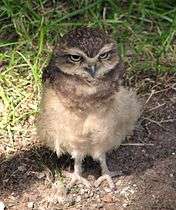 Immature
Immature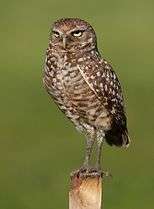 A. c. floridana, adult, Pembroke Pines, Florida
A. c. floridana, adult, Pembroke Pines, Florida Five southern burrowing owls
Five southern burrowing owls
Taxonomy and systematics
The burrowing owl is sometimes classified in the monotypic genus Speotyto based on an overall different morphology and karyotype. However, osteology and DNA sequence data suggest that the burrowing owl is a terrestrial member of the Athene little owls, and it is today placed in that genus by most authorities.
A considerable number of subspecies have been described, but they differ little in appearance and the taxonomy of several need to be validated.[5] Most subspecies are found in/near the Andes and in the Antilles. Although distinct from each other, the relationship of the Floridian subspecies to (and its distinctness from) the Caribbean birds is not quite clear.[6]
- A. c. cunicularia (Molina, 1782): Southern burrowing owl – Lowlands of S Bolivia and S Brazil south to Tierra del Fuego. Probably includes partridgei.
- A. c. grallaria (Temminck, 1822): Brazilian burrowing owl – Central and E Brazil.
- A. c. hypugaea (Bonaparte, 1825): Northern (or western) burrowing owl – S Canada through Great Plains south to Central America.
- A. c. floridana (Ridgway, 1874): Florida burrowing owl – Florida and Bahamas.
- A. c. guadeloupensis (Ridgway, 1874): Guadeloupe burrowing owl – Formerly Guadeloupe and Marie-Galante Islands; extinct (c.1890).
- A. c. amaura (Lawrence, 1878): Antiguan burrowing owl – Formerly Antigua, Saint Kitts, and Nevis Islands; extinct (c.1905).
- A. c. troglodytes (Wetmore & Swales, 1886): Hispaniolan burrowing owl – Hispaniola, Gonâve Island, and Beata Island.
- A. c. rostrata (C. H. Townsend, 1890): Revillagigedo burrowing owl – Isla Clarión, Revillagigedo Islands.
- A. c. nanodes (Berlepsch & Stolzmann, 1892): Southwest Peruvian burrowing owl – SW Peru. Might include intermedia.
- A. c. brachyptera (Richmond, 1896): Margarita burrowing owl – Isla Margarita. Might include apurensis.
- A. c. tolimae (Stone, 1899): West Colombian burrowing owl – W Colombia. Might include carrikeri.
- A. c. juninensis (Berlepsch & Stolzmann, 1902): South Andean burrowing owl – Andes from Central Peru to NW Argentina. Might include punensis.
- A. c. punensis (Chapman, 1914): Puna burrowing owl – Altiplano region around Peruvian-Ecuadorian border. Doubtfully distinct from juninensis.
- A. c. arubensis (Cory, 1915): Aruba burrowing owl – Aruba.
- A. c. intermedia (Cory, 1915): West Peruvian burrowing owl – W Peru. Doubtfully distinct from nanodes.
- A. c. minor (Cory, 1918): Guyanan burrowing owl – S Guyana and Roraima region.
- A. c. carrikeri (Stone, 1922): East Colombian burrowing owl – E Colombia. Doubtfully distinct from tolimae.
- A. c. pichinchae (Boetticher, 1929): West Ecuadorean burrowing owl – W Ecuador.
- A. c. boliviana (L. Kelso, 1939): Bolivian burrowing owl – Bolivian altiplano.
- A. c. apurensis (Gilliard, 1940): Venezuelan burrowing owl – NW Venezuela. Doubtfully distinct from brachyptera.
- A. c. partridgei (Olrog, 1976): Corrientes burrowing owl – Corrientes Province, Argentina. Probably not distinct from cunicularia.
- A. c. guantanamensis (Garrido, 2001): Cuban burrowing owl – Cuba and Isla de la Juventud.
A paleosubspecies, A. c. providentiae, has been described from fossil remains from the Pleistocene of the Bahamas. How these birds relate to the extant A. c. floridana – that is, whether they were among the ancestors of that subspecies, or whether they represented a more distant lineage that completely disappeared later – is unknown.
In addition, prehistoric fossils of similar owls have been recovered from many islands in the Caribbean (Barbuda, Cayman Islands, Jamaica, Mona Island, and Puerto Rico). These birds became extinct towards the end of the Pleistocene, probably because of ecological and sea level changes at the end of the last ice age rather than human activity. These fossil owls differed in size from present-day burrowing owls, and their relationship to the modern taxon has not been resolved.
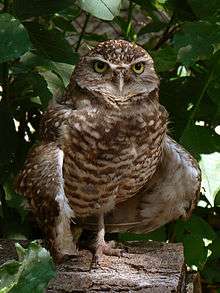 Northern burrowing owl (A. c. hypugaea)
Northern burrowing owl (A. c. hypugaea) Florida burrowing owl (A. c. floridana)
Florida burrowing owl (A. c. floridana)
Florida (USA)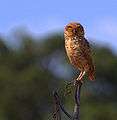
 Southern burrowing owl (A. c. cunicularia)
Southern burrowing owl (A. c. cunicularia)
Uruguay
Range and ecology
Before European colonization, burrowing owls probably inhabited every suitable area of the New World, but in North America, they have experienced some restrictions in distribution since. In parts of South America, they are expanding their range with deforestation.[7] The western burrowing owls (A. c. hypugaea) are most common in the Rocky Mountain Arsenal National Wildlife Refuge and in several counties in Colorado, and their population reportedly is threatened.[8]
Burrowing owls range from the southern portions of the western Canadian provinces through southern Mexico and western Central America. They are also found in Florida and many Caribbean islands. In South America, they are patchy in the northwest and through the Andes, but widely distributed from southern Brazil to Patagonia and Tierra del Fuego. Burrowing owls are year-round residents in most of their range. Birds that breed in Canada and the northern USA usually migrate south to Mexico and southern USA during winter months.
This species can live for at least 9 years in the wild and over 10 years in captivity.[2] They are often killed by vehicles when crossing roads, and have many natural enemies, including badgers, coyotes, and snakes. They are also killed by both feral and domestic cats and dogs. Two birds studied in the Parque Nacional de La Macarena of Colombia were free of blood parasites.[9]
Burrowing owls often nest and roost in the burrows made by ground squirrels, a strategy also used by rattlesnakes. When threatened the owl retreats to the burrow and produces rattling and hissing sounds similar to that of a rattlesnake. The behavior is suggested to be an example of acoustic Batesian mimicry and has been observed to be an effective strategy against animals that are familiar with dangers posed by rattlesnakes.[10]
Food and feeding
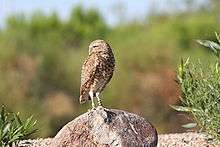
When hunting, they wait on a perch until they spot prey. Then, they swoop down on prey or fly up to catch insects in flight. Sometimes, they chase prey on foot across the ground. The highly variable diet includes invertebrates and small vertebrates, which make up roughly one-third and two-thirds of the diet, respectively. Burrowing owls mainly eat large insects and small rodents. Although burrowing owls often live close to ground squirrels (Marmotini), they rarely prey upon them.
Rodent prey is usually dominated by locally superabundant species, like the delicate vesper mouse (Calomys tener) in southern Brazil. Among squamates and amphibians, small lizards like the tropical house gecko (Hemidactylus mabouia), and frogs and toads predominate. Generally, most vertebrate prey is in the weight class of several grams per individual.[11] The largest prey are usually birds, such as eared doves (Zenaida auriculata) which may weigh almost as much as a burrowing owl.[12]
Regarding invertebrates, the burrowing owl seems less of a generalist. It is extremely fond of termites such as Termitidae, and Orthoptera such as Conocephalinae and Copiphorinae katydids, Jerusalem crickets (Stenopelmatidae) and true crickets (Gryllidae). Bothynus and Dichotomius anaglypticus scarab beetles (Scarabaeidae) were eaten far more often than even closely related species by many burrowing owls across central São Paulo (Brazil). Similarly, it was noted that among scorpions Bothriuridae were much preferred, among spiders Lycosidae (wolf spiders), and among millipedes (Diplopoda) certain Diplocheta. Small ground beetles (Carabidae) are eaten in quantity, while larger ones are much less popular as burrowing owl food, perhaps due to the vigorous defense the large species can put up.[12] Burrowing owls are also known to place the fecal matter of large herbivorous mammals around the outside of their burrows to attract dung beetles which are used to provide a steady source of food for the owls.
Unlike other owls, they also eat fruits and seeds, especially the fruit of tasajillo (Cylindropuntia leptocaulis) and other prickly pear and cholla cacti. On Clarion Island, where mammalian prey is lacking, they feed essentially on crickets and prickly pear fruit, adding Clarión wrens (Troglodytes tanneri) and young mourning doves (Zenaida macroura clarionensis) on occasion.[13]
Reproduction
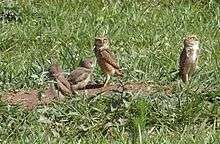
The nesting season begins in late March or April in North America. Burrowing owls usually only have one mate but occasionally a male will have two mates.[2] Pairs of owls will sometimes nest in loose colonies. Their typical breeding habitat is open grassland or prairie, but they can occasionally adapt to other open areas like airports, golf courses, and agricultural fields. Burrowing owls are slightly tolerant of human presence, often nesting near roads, farms, homes, and regularly maintained irrigation canals.
The owls nest in an underground burrow, hence the name burrowing owl. If burrows are unavailable and the soil is not hard or rocky, the owls may excavate their own. Burrowing owls will also nest in shallow, underground, man-made structures that have easy access to the surface.
During the nesting season, burrowing owls will collect a wide variety of materials to line their nest, some of which are left around the entrance to the burrow. The most common material is mammal dung, usually from cattle. At one time it was thought that the dung helped to mask the scent of the juvenile owls, but researchers now believe the dung helps to control the microclimate inside the burrow and to attract insects, which the owls may eat.[14]
The female will lay an egg every one or two days until she has completed a clutch, which can consist of 4 to 12 eggs (usually 9). She will then incubate the eggs for three to four weeks while the male brings her food. After the eggs hatch, both parents will feed the chicks. Four weeks after hatching, the chicks can make short flights and begin leaving the nest burrow. The parents will still help feed the chicks for one to three months. While most of the eggs will hatch, only four to five chicks usually survive to leave the nest.
Site fidelity rates appear to vary among populations. In some locations, owls will frequently reuse a nest several years in a row. Owls in migratory northern populations are less likely to return to the same burrow every year. Also, as with many other birds, the female owls are more likely to disperse to a different site than are male owls.[15]
Status and conservation
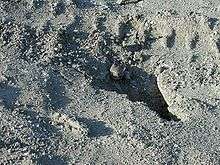
The burrowing owl is endangered in Canada,[16] threatened in Mexico, and a species of special concern in Florida and most of the western USA. It is a state threatened species in Colorado. It is common and widespread in open regions of many Neotropical countries, where they sometimes even inhabit fields and parks in cities. In regions bordering the Amazon Rainforest they are spreading with deforestation.[7] It is therefore listed as Least Concern on the IUCN Red List.[1] Burrowing owls are protected under the Migratory Bird Treaty Act in Canada, the United States, and Mexico. They are also included in CITES Appendix II.
The major reasons for declining populations in North America are control programs for prairie dogs and loss of habitat. Burrowing owls readily inhabit some anthropogenic landscapes, such as airport grasslands or golf courses, and are known to take advantage of artificial nest sites (plastic burrows with tubing for the entrance) and perches.[17][18] Genetic analysis of the two North American subspecies indicates that inbreeding is not a problem within those populations.[6]
Where the presence of burrowing owls conflicts with development interests, a passive relocation technique has been applied successfully: rather than capturing the birds and transporting them to a new site (which may be stressful and prone to failure), the owls are half-coerced, half-enticed to move on their own accord. The preparations need to start several months prior to the anticipated disturbance with observing the owl colony and noting especially their local movements and site preferences. After choosing a location nearby that has suitable ground and provides good burrowing owl breeding habitat, this new site is enhanced by adding burrows, perches, etc. Once the owls have accustomed to the changes and are found to be interested in the location – if possible, this should be at the onset of spring, before the breeding season starts – they are prevented from entering the old burrows. A simple one-way trapdoor design has been described that is placed over the burrow for this purpose.[19] If everything has been correctly prepared, the owl colony will move over to the new site in the course of a few nights at most. It will need to be monitored occasionally for the following months or until the major human construction nearby has ended.[20]
In popular culture
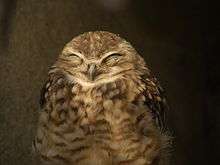
In fiction
- Carl Hiaasen's young adult novel Hoot (2002) is about a group of school children trying to stop the planned construction of a pancake house that would go hand in hand with the destruction of burrowing owl habitat in a small town in Florida.[21] Live burrowing owls were featured in the New Line Cinema and Walden Media movie adaptation.
- A burrowing owl named Digger features in the Guardians of Ga'Hoole series by Kathryn Lasky. He is a major character in the series. There are several less prominent burrowing owls in the series. Digger is also featured in the 2010 film based on the series.
In sports
- The burrowing owl is the official mascot for the intercollegiate athletic teams of Florida Atlantic University;[22] as the owls had made their home on the campus (the site of a former military base) prior to the campus opening (the campus would later become a National Audubon Society designated burrowing owl sanctuary). (The sports teams, though, simply go by "Owls".)
References
- 1 2 BirdLife International (2012). "Athene cunicularia". IUCN Red List of Threatened Species. Version 2013.2. International Union for Conservation of Nature. Retrieved 26 November 2013.
- 1 2 3 4 5 Lewis, D.P. (2005). "Burrowing Owl – Athene cunicularia". OwlPages.com. Owl Species ID: 220.040.000. Retrieved 24 April 2005.
- ↑ "Burrowing Owl". All About Birds. Cornell Lab of Ornithology.
- ↑ "All about Burrowing Owls". Burrowing Owl Conservation Society of BC.
- ↑ Holt, D.W.; Berkley, R.; Deppe, C.; Enríquez Rocha, P.L.; Petersen, J.L.; Rangel Salazar, J.L.; Segars, K.P.; Wood, K.L. (1999). del Hoyo, J.; Elliott, A.; Sargatal, J., eds. 155. Burrowing Owl. Handbook of the Birds of the World. Volume 5: Barn-owls to Hummingbirds. Barcelona: Lynx Edicions. pp. 227–228, plate 17. ISBN 84-87334-25-3.
- 1 2 Korfanta, N.M.; McDonald, D.B.; Glenn, T.C. (2005). "Burrowing owl (Athene cunicularia) population genetics: A comparison of North American forms and migratory habits" (PDF). Auk. 122 (2): 464–478. doi:10.1642/0004-8038(2005)122[0464:BOACPG]2.0.CO;2. JSTOR 4090439.
- 1 2 Gomes, F.B.R.; Mello Barreiros, M.H.; Krempel Santana, T.B. (2013). "Novos registros da expansão geográfica de Athene cunicularia na Amazônia central com especial referência as atividades humanas" [New records of the geographical expansion of Athene cunicularia in central Amazonia with particular reference to human activities]. Atualidades Ornitológicas (in Portuguese). 172: 8.
- ↑ Klute, David S.; Ayers, Loren W.; Green, Michael T.; Howe, William H.; Jones, Stephanie L.; Shaffer, Jill A.; Sheffield, Steven R.; Zimmerman, Tara S. (2003). "Status Assessment and Conservation Plan for the Western Burrowing Owl in the United States" (PDF). Washington, D.C.: U.S. Department of Interior, Fish and Wildlife Service. Biological Technical Publication FWS/BTP-R6001-2003.
- ↑ Basto, Natalia; Rodríguez, Oscar A.; Marinkelle, Cornelis J.; Gutierrez, Rafael; Matta, Nubia Estela (2006). "Haematozoa in birds from la Macarena National Natural Park (Colombia)". Caldasia. 28 (2): 371–377. JSTOR 23641756.
- ↑ Rowe, Matthew P.; Cross, Richard G.; Owings, Donald H. (2010). "Rattlesnake Rattles and Burrowing Owl Hisses: A Case of Acoustic Batesian Mimicry". Ehtology. 72 (1): 53–71. doi:10.1111/j.1439-0310.1986.tb00605.x.
- ↑ Fig. 1 in Motta-Junior (2006) is misleading: it shows the average weight of both vertebrate and invertebrate components. Compare Tyto alba, which feeds almost exclusively on the same sort of rodents and other small vertebrates (but not invertebrates) as A. cunicularia.
- 1 2 Motta-Junior, José Carlos (2006). "Relações tróficas entre cinco Strigiformes simpátricas na região central do Estado de São Paulo, Brasil" [Comparative trophic ecology of five sympatric Strigiformes in central State of São Paulo, south-east Brazil]. Revista Brasileira de Ornitologia (in Portuguese). 14 (4): 359–377.
- ↑ Brattstrom, Bayard H.; Howell, Thomas R. (1956). "The Birds of the Revilla Gigedo Islands, Mexico" (PDF). Condor. 58 (2): 107–120. doi:10.2307/1364977.
- ↑ Levey, D.J.; Duncan, R.S.; Levins, C.F. (2004). "Use of dung as a tool by burrowing owls" (PDF). Nature. 431 (7004): 39. doi:10.1038/431039a. PMID 15343324.
- ↑ Lutz, R.S.; Plumpton, D.L. (1999). "Philopatry and nest site reuse by burrowing owls: implications for productivity". Journal of Raptor Research. 33 (2): 149–153.
- ↑ "Species Profile – Burrowing Owl". Species at Risk Public Registry. Environment Canada. Retrieved 8 May 2006.
- ↑ Larsen, Eric M.; Azerrad, Jeffrey M. and Nordstrom, Noelle, ed. (May 2004). Priority Habitat and Species Management Recommendations, Volume IV: Birds: Burrowing Owl (PDF). Washington Department of Fish & Wildlife. Archived from the original (PDF) on August 26, 2010. Retrieved 3 April 2010.
- ↑ "Artificial Burrows". Burrowing Owl Preservation Society. Archived from the original on 30 November 2010. Retrieved 3 April 2010.
- ↑ Clark, H.O. Jr.; Plumpton, D.L. (2005). "A simple one-way door design for passive relocation of Western Burrowing Owls". California Fish and Game. 91 (4): 286–289.
- ↑ Trulio, Lynne A. (1995). "Passive relocation: A method to preserve burrowing owls on disturbed sites" (PDF). Journal of Field Ornithology. 66 (11): 99–106.
- ↑ Hiaasen, Carl (2002). Hoot. Knopf. ISBN 0-582-84859-8.
- ↑ "FAU Traditions". Florida Atlantic University: Athletics Department. Retrieved 25 April 2011.
Further reading
- DeSante, D.F.; Ruhlen, E.D.; Rosenberg, D.K. (2004). "Density and abundance of burrowing owls in the agricultural matrix of the Imperial Valley, California" (PDF). Studies in Avian Biology. 27: 116–119.
- Haug, E.A.; Milsap, B.A.; Martell, M.S. (1993). Poole, A., ed. "Burrowing owl (Athene cunicularia)". The Birds of North America Online. Ithaca: Cornell Lab of Ornithology. doi:10.2173/bna.61. Retrieved 26 December 2006. (subscription required (help)).
- Konig, C.; Weick, F.; Becking, J.-H. (1999). Owls: A guide to the owls of the world. New Haven: Yale University Press. ISBN 0-300-07920-6.
- Moulton, C.E.; Brady, R.S.; Belthoff, J.R. (2005). "A comparison of breeding season food habits of burrowing owls nesting in agricultural and nonagricultural habitat in Idaho". Journal of Raptor Research. 39: 429–438.
External links
| Wikimedia Commons has media related to Athene cunicularia. |
| Wikispecies has information related to: Athene cunicularia |
- Burrowing Owl Live Camera Feed & Fact Sheet at critterzoom.com
- BirdLife species factsheet for Athene cunicularia
- Rocky Mountain Arsenal National Wildlife Refuge: Burrowing Owl Study
- Burrowing Owl Species Account – Cornell Lab of Ornithology
- "Burrowing owl media". Internet Bird Collection.
- Burrowing Owl Conservation Network
- Burrowing Owl Photo Essay at The Ark in Space
- Burrowing owl photo gallery at VIREO (Drexel University)
